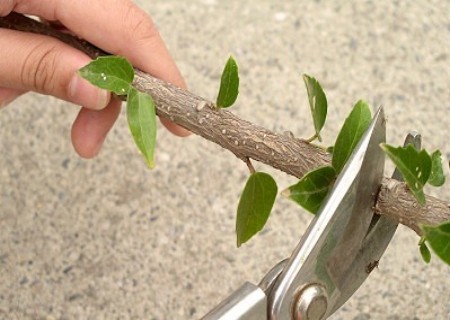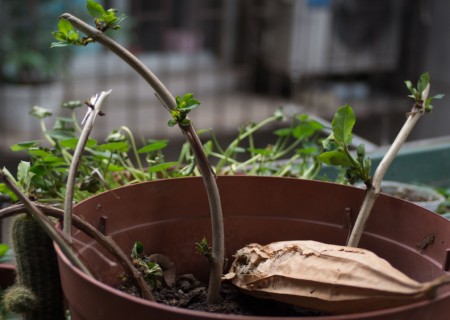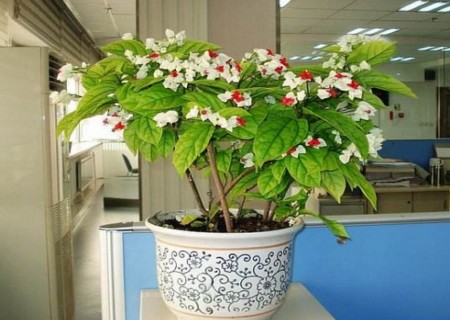Illustration of new techniques for plant cutting propagation
Plant cuttage is one of the excellent methods of seedling culture. Cutting propagation is to use the regeneration ability of plant roots, stems, leaves and buds to make it take root and sprout to form new plants under appropriate conditions, which has the characteristics of fast propagation, easy collection, small genetic change, convenient management and so on.
The weather is getting hotter every day, and it is a good season for many flower lovers to reproduce their beloved plants at home in the early summer of each year. Cutting is a method of flower reproduction, which is to cut part of the plant tissue and breed new plants by certain means, and it is also the simplest way to propagate plants that are most suitable for flower friends to operate at home. The following is to introduce the new technology of plant cutting propagation (illustration):
1. Choose the right cuttings

The branches used for cutting propagation are called cuttings. After cutting, the cuttings will first form the root source, and then grow new roots from the root body. Cuttings should be cut from healthy and pest-free mother plants. The more vigorous the mother plant is, the faster the cuttings take root. Generally speaking, the new branch is easier to root than the aged branch, and the growing branch is easier to root than the dormant branch, so the cuttings should be medium-ripe, full and full, and the branches between green shoots and brown woody old branches should be selected for cutting cuttings.
2. Oblique cutting at the lower end of the cuttings
Cutting cuttings should use sharp cuttings or blades, the cut should be smooth, should be cut down, clean and neat, in order to benefit the root; if the cut is injured, it is easy to cause rot in the soil. When cutting, it is divided into 2-3 segments with a length of about 10-15 cm. In order to avoid being unable to root upside down, attention should be paid to the position of axillary buds and leaf marks when shearing, and the upper end of the cuttings can also be flat-cut and the lower end of the cuttings can be identified.
3. Trim excess blades
In order to avoid rapid dehydration and withering of the cuttings, the lower leaves of the cuttings should be completely cut off, and the upper leaves can also be completely cut off, or 3-4 leaves can be retained. When the leaves are too large, they should be cut in half, and the buds and buds should also be cut off. The faster the cuttings were cut, the higher the survival rate was. If it is not cut immediately, it should be covered with a moist cloth, napkin or water moss, or put into a plastic bag and dripped with appropriate moisture to moisturize. However, succulent plants, such as cactus, egg flowers, desert roses, etc., because the plant contains a lot of juice, cut the cuttings, but should wait for the incision to completely solidify before cutting, so as to avoid base rot.
4. Apply rooting agent
Smearing rooting agents on cuttings before cutting, such as Aigen, can effectively promote rooting and improve the survival rate of cuttings. There are two kinds of rooting agents sold in the market: liquid agent and powder. A large number of cuttings are commonly treated with liquid agent, and a small number of cuttings are more convenient with powder. Plants that are easy to propagate by cutting, such as Datura, Magnolia, Cui Luli, etc., can grow smoothly even if they are not smeared with rooting agents.
5. Poke a hole with a tool
After the soil surface is leveled, in order to avoid the friction injury between the bud points on the branches and the soil, and the rooting agent of the cuttings cut touching and scattered with the soil, fingers, penholder, bamboo sticks or other tools similar to the thickness of cuttings should be used to poke holes in the soil surface. Do not insert cuttings directly into the soil. Medium materials must have drainage, good ventilation, easy to keep wet and other conditions, coarse sand, vermiculite, perlite, peat moss, fine snake sawdust and so on are very suitable.
6. Pay attention to the cutting depth
Insert the cuttings into the hole, press them tightly and fix them with your hands, so that the base of the cuttings is in close contact with the medium, and then water them thoroughly. The depth of cutting is about 2/5 of the length of cuttings, too deep is easy to cause water rot at the base of cuttings, and too shallow is easy to cause water evaporation and rapid withering. Usually, cutting herbaceous flowers can take root in about 1-2 weeks, foliage plants and woody soft branches take about 3-4 weeks, and general hardwood cuttings take about a month to root.
7. Management after cuttage
The optimal temperature for cutting is about 20-25 ℃, which needs soft light (about 40-60%). After cutting, it should be placed in a shady, bright and ventilated environment. In order to reduce the rapid evapotranspiration of water, strong direct sunlight should be absolutely avoided, which can be shaded by gauze and shading net, but excessive shading can not carry out photosynthesis, even if the hairy root is difficult to survive. Cuttings should be kept at a high air humidity (about 70-80%) before rooting, and should be kept moist by regular spray, but cutting succulent plants should be kept in a semi-dry state to avoid cutting rot. During the period of low temperature or cold current in winter, water should be avoided in the evening or at night to avoid cuttings or soil stagnant overnight, resulting in cold injury or frostbite.
8. Moisturizing with transparent plastic bags
For plants that are not easy to root, transparent glass, plastic sheeting or plastic bags can be used to seal the bed or culture pot to prevent water evaporation and maintain high humidity of the air, which has a significant effect on improving the survival rate. The plastic bag should be removed in about 7-10 days, and it is easy to cause cuttings mildew due to stuffy air for too long. After the cuttings germinate new buds, grow normally, and observe the vigorous development of the root group from the bottom drainage hole, it should be transplanted in time.
The management of potted plants after cutting is mainly watering and shading to prevent excessive evaporation and water loss and affect survival. Because the cuttings have no roots, and there are a small number of leaves above ground, the cuttings have only water evaporation but no absorption function, so the water in the cuttings can not be balanced and need to be absorbed after rooting. Therefore, in the cutting management, we must keep the soil moist, pay attention to shading, ventilate and penetrate in the morning, water after rooting, and gradually increase the sunshine time. The work of weeding and disinfestation should be carried out at any time. After taking root and growing new leaves, compound fertilizer can be sprayed once, and the plant can be transplanted after it is strong.
No matter what kind of cutting method is adopted, we must pour enough water after cutting, and then cover the cutting pot with glass or plastic film, in order to maintain a certain temperature and humidity, put it in the semi-shade, strengthen management, and then transplant and culture after rooting. In order to make the cuttage survival rate high, in addition to selecting good cuttings, the substrate is also very important, the substrate should not only have good drainage, but also have a certain degree of water retention. Vermiculite, perlite, slag and rice bran ash are better cutting substrates. The substrate should be kept above 20 ℃, that is, the atmospheric temperature should be above 25 ℃, so that the cuttings can be easily healed and rooted.
Time: 2019-06-09 Click:
- Prev

Diagram of cutting method of Flos Lonicerae
Honeysuckle is one of the 38 valuable traditional Chinese medicines under national key management. It has a wide range of uses in medicine, health care, economic ecology and other aspects. The wide use of honeysuckle has brought huge economic benefits. with the successive development of all kinds of honeysuckle products, the market demand has increased exponentially.
- Next

The cuttage method of dragon spitting pearl (diagram of branch cutting technique)
Longtuzhu flower is native to tropical Africa, which can be divided into white calyx dragon bead and red calyx dragon bead. The flower is very beautiful, the color of the flower is in sharp contrast, and the flower shape is as peculiar as the dragon spitting pearl, which is the top grade of potted flowers. The dragon spits the pearl leaf color is thick green, the calyx is like jade, the Corolla is scarlet, full of poetic feeling. When the dragon spits beads in full bloom
Related
- Fuxing push coffee new agricultural production and marketing class: lack of small-scale processing plants
- Jujube rice field leisure farm deep ploughing Yilan for five years to create a space for organic food and play
- Nongyu Farm-A trial of organic papaya for brave women with advanced technology
- Four points for attention in the prevention and control of diseases and insect pests of edible fungi
- How to add nutrient solution to Edible Fungi
- Is there any good way to control edible fungus mites?
- Open Inoculation Technology of Edible Fungi
- Is there any clever way to use fertilizer for edible fungus in winter?
- What agents are used to kill the pathogens of edible fungi in the mushroom shed?
- Rapid drying of Edible Fungi

